Gin no Bashamichi — Prominent Figures
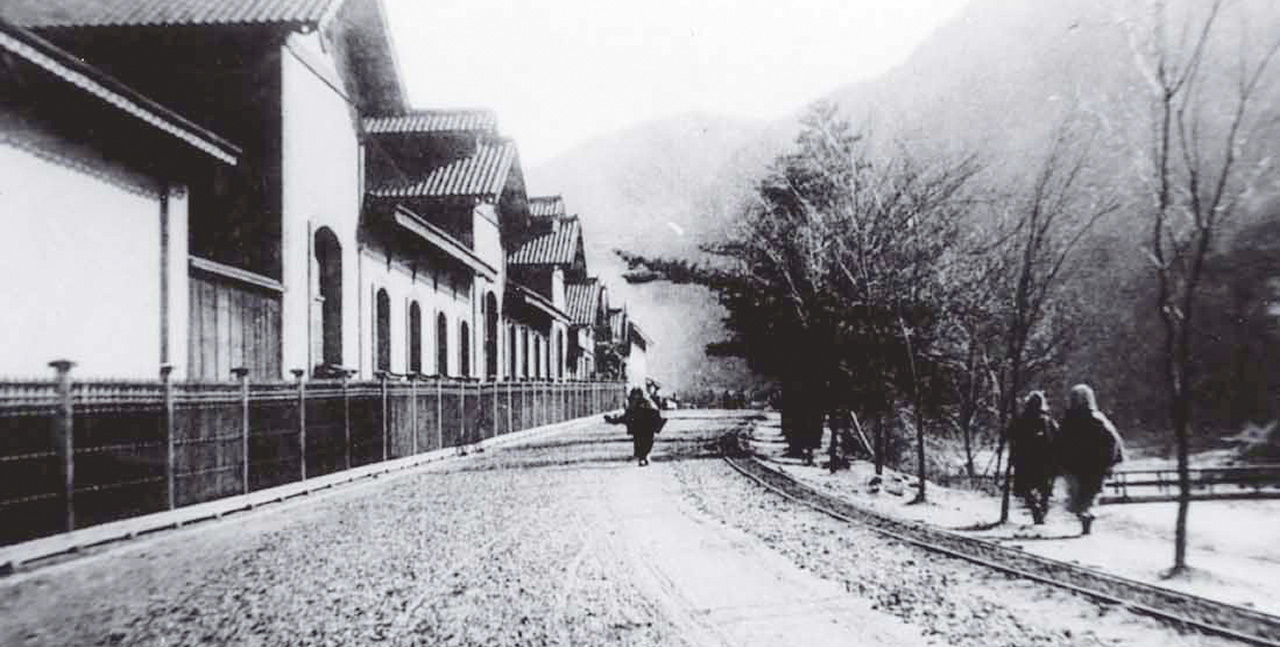
Many incredible people have made their mark along the Old Silver Mine Carriage Road. An important factor in the development of the Ikuno Silver Mine and surrounding mines, Gin no Bashamichi drew some of the most prominent figures from both throughout Japan and around the world. The areas along Gin no Bashamichi are also home to several well-known historical figures. Inspired by the new culture and civilization travelling along Gin no Bashamichi, and thanks to the opportunities for connections throughout the world, those ambitious individuals with a spirit for enterprise went on to influence a variety of fields.
 Hideyoshi Toyotomi
Hideyoshi Toyotomi Kanbei Kuroda
Kanbei Kuroda Moriaki Asakura
Moriaki Asakura Jean Francisque Coignet
Jean Francisque Coignet Leon Sisley
Leon Sisley Tokuzo Takashima
Tokuzo Takashima Rihachi Naito
Rihachi Naito Teijiro Asada
Teijiro Asada Kunio Yanagita
Kunio Yanagita Takashi Shimura
Takashi Shimura
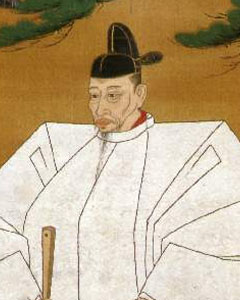 Reproduced with permission from the University of Tokyo’s Historiographical Institute
Reproduced with permission from the University of Tokyo’s Historiographical Institute
Hideyoshi Toyotomi(1536-1598)
Hideyoshi Toyotomi was military commander from the Sengoku period to the Azuchi–Momoyama period. After first serving the Imagawa clan under the name Kinoshita Tokichiro, Toyotomi became an officer in the Oda clan. The tale of Toyotomi being a sandal-bearer for Nobunaga Oda is a common anecdote. After Nobunaga’s death, Toyotomi became Kampaku and Daijo Daijin (Regent and Chancellor of the Realm) and oversaw the unification of Japan. As an award for the campaign against Tajima Province, Nobunaga gave Hideyoshi Toyotomi the Ikuno Silver Mine. To ensure direct control even after Nobunaga’s death, Toyotomi set up a magistrate’s office in Ikuno and vigorously promoted development of the mine as a source of income. In a letter written in 1584, Toyotomi—under the name Hideyoshi Hashiba—also designated “Harima Shikama” as the delivery location for goods. This laid the foundation for prosperity in the Shikama-tsu Port and Himeji areas.
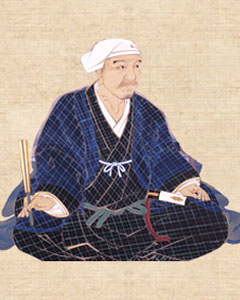
Fukuoka City Museum Collection
Kanbei Kuroda(1546-1604)
Kanbei Kuroda was a military commander and daimyo from the Sengoku period to the early Edo period. An important figure closely related to the “three heroes” of the Sengoku period (Nobunaga Oda, Hideyoshi Toyotomi, and Ieyasu Tokugawa), Kuroda would become the ancestor of the Fukuoka clan in Chikuzen Province (now part of Fukuoka Prefecture). Although he is commonly known as “Kanbei,” his real name was “Yoshitaka”. In 1575, Harima became sandwiched between Oda and Mori as a type of buffer zone. Kuroda’s master, Masamoto Kodera, was concerned who he would side with, but Kuroda was of the mind that they should align themselves with Oda, who was constantly on the offensive, rather than Mori, who focused solely on defense. As a result, Kuroda transferred control over Himeji Castle to Hideyoshi, who had recently been sent into the Himeji region. Hideyoshi would later rule over a unified Japan with Kuroda as a chief strategist and adviser.
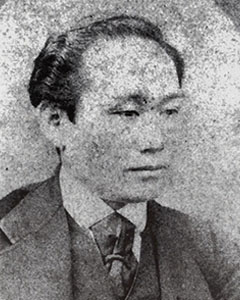 Photo provided by the Asago
Photo provided by the AsagoCity Board of Education
Moriaki Asakura(1843-1924)
Born in the Satsuma Domain, Moriaki Asakura was a student of medicine and a member of the famed “Satsuma Students.” Moving from the UK to France, Asakura studied languages and mining studies before returning to Japan. Asakura served as a French teacher at a Kaiseijo (school of foreign studies) in the Satsuma Domain. Following the Meiji Restoration in 1868, Asakura was hired to accompany a foreigner, Jean Francisque Coignet, working at the Ikuno Silver Mine. He was 25 at the time. Utilizing the latest precision ore analysis technology, pump-powered drainage, and various mining methods using Western instruments and explosives, Asakura and Coignet oversaw the revitalization and modernization of the Ikuno Silver Mine. For 25 years, Asakura greatly contributed to the development of the Ikuno Silver Mine through the introduction of large machinery from both Japan and overseas, and through the construction of a new road specifically designed for horse-drawn carriages. Asakura was the Ikuno Silver Mine’s first mining director.
Personal History| Personal History | |
|---|---|
| 1843 | Born the second son of a samurai of the Satsuma Domain; studied medicine and Western learning from a young age |
| 1865 | Studied abroad in the UK by decree of the Satsuma Domain |
| 1866 | Moved from the UK to France to study French and mining |
| 1867 | Returned to Japan and worked as a French teacher at a Kaiseijo (school of foreign studies) in the Satsuma Domain |
| 1868 | Entered service as an interpreter for Jean Francisque Coignet, a French mining technician, and began redevelopment of the Ikuno Silver Mine |
| 1872 | Became assistant to the Minister of Industry |
| 1873 | Began construction on Gin no Bashamichi under Leon Sisley as chief engineer |
| 1875 | Completed construction of the first Moriaki Bridge and Ikuno Bridge (formerly Yabuta Bridge) |
| 1876 | Finished construction of both Shikama-tsu wharf and Gin no Bashamichi |
| 1883 | Became director of Ikuno Silver Mine |
| 1886 | Became Chief Secretariat of Ikuno Silver Mine |
| 1889 | Became head of the subprefecture of Ikuno |
| 1893 | Resigned due to poor health and relocated to Osaka and eventually Kyoto City |
| 1895 | Bantan Railroad between Ikuno and Shikama opens |
| 1920 | Gin no Bashamichi is abandoned |
| 1924 | Dies in Kyoto at the age of 81 |
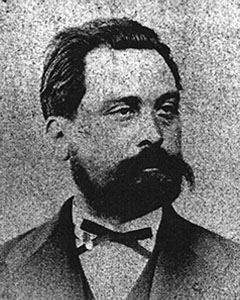 Photo provided by the Asago City
Photo provided by the Asago CityBoard of Education
Jean Francisque Coignet(1835-1902)
Jean Francisque Coignet was born in the mining city of Saint-Étienne in 1835 . After graduating from a national mining school, Coignet gained experience as a mining engineer in Europe, the United States, and other countries. In 1867, he came to Japan under an invitation by the Satsuma Domain. Following the collapse of the shogunate regime, Coignet was contracted by the new Meiji government in 1868 and began working at the Ikuno Silver Mine with Moriaki Asakura. Through advanced technology including the introduction of gunpowder explosives, track laying, and hoisting machines, Coignet oversaw enhanced productivity at the mine and was instrumental in the modernization of the mine. He also opened a scholastic laboratory in 1869 to conduct practical mining education. Continuing on to various locations throughout Japan, the many technicians trained under Coignet used their newfound knowledge to support the development of Meiji Japan.
Coignet worked at the Ikuno Silver Mine from June 1868 to January 1878.
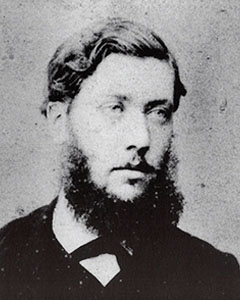 Photo provided by the Asago
Photo provided by the AsagoCity Board of Education
Leon Sisley(1847-1878)
Born in 1847, Leon Sisley was a soil specialist and mine engineer. Sisley was responsible for designing Gin no Bashamichi—Japan’s first paved road that would revolutionize distribution within Japan. Overseeing the construction of the horse-drawn carriage road, Sisley incorporated state-of-the-art technology and ingenuity, including macadam road construction popular in Europe at the time. Covering some 49 kilometers from the inland Ikuno Silver Mine to Shikama-tsu Port on the shores of the Seto Inland Sea, Gin no Bashamichi (Old Silver Mine Carriage Road) is a durable horse-drawn carriage road blessed with mild elevation differences, a gentle, curving gradient, and good drainage, making for a faster, safer way to travel. Sisley was also responsible for the building designs of Shikama-tsu wharf (Himeji City), the arrival and departure point for the horse-drawn carriageway. Jean Francisque Coignet was Sisley’s brother in law.
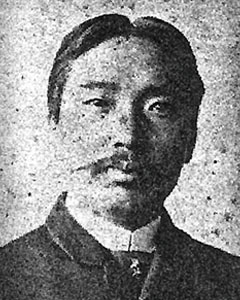 Shimonoseki City Art Museum
Shimonoseki City Art MuseumCollection
Tokuzo Takashima (Hokkai Takashima) (1850-1931)
Born in 1850, Tokuzo Takashima was the son of a doctor in the Hagi Domain. After moving to the Ikuno Silver Mine in 1872, Takashima studied French, geology, and botany under Coignet and Sisley through the mine’s experimental scholastic site and chose to reside in Ikuno even after he no longer worked at the mine. In addition to serving as an interpreter, Takashima accompanied Coignet on geological surveys throughout Japan and in 1874 completed the “Yamaguchi Prefecture Geological Map” and the “Yamaguchi Prefecture Geological Color Diagram”—the first geological maps of Japan—thus greatly contributing to the modernization of Japan. Later in life, Takashima became widely known as a successful Japanese painter under the name Hokkai Takashima. Takashima attended the Meirinkan kan school in the Choshu Domain alongside Maresuke Nogi, a prominent figure in the Meiji period.
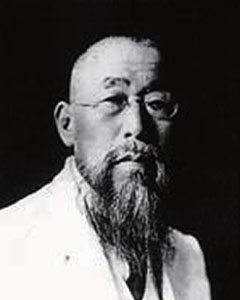 Courtesy of Ichikawa Town
Courtesy of Ichikawa TownCultural Center
Rihachi Naito(1856-1921)
Rihachi Naito was a Japanese politician and businessman born on February 6, 1856. In 1887, Naito submitted to the governor of Hyogo Prefecture plans with Teijiro Asada for converting the Gin no Bashamichi to a horse-drawn railway line. Those plans were later changed for steam power locomotives, culminating in the creation of the Bantan Railway (currently named the JR Bantan Line). Naito was one of the founders of the Bantan Railway and invested personal property and devotion in addition to playing an important role in the railway’s land acquisitions. The Bantan Railway opened in 1894 between Himeji and Teramae. Following the opening, Naito was named president of the railway and helped contribute to the economic development of the Harima area by establishing an electric power business, a bank, and a cotton-spinning company. A monument praising Naito’s accomplishments can be found at Ichikawa’s Amaji Ekimae-koen Park.
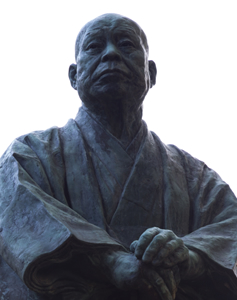
Teijiro Asada(1855-1942)
Born in 1855, Teijiro Asada was the fourth son of a samurai in the Fukumoto Domain. At 17, Teijiro was adopted into the Asada family, which had served for generations under the Ikuno magistrate’s office. He then focused his attention on developing the mines and gained the trust and confidence of 11 towns and villages around the mine, eventually becoming the leader of the towns. Asada then became engaged in national politics following service as a member of the Hyogo Prefectural Assembly councilor and subsequently a member of the House of Representatives. As profit from the mine was ordered to be paid to the private sector in 1896, Asada oversaw the delivery of the subsidies as a representative of the townspeople. In addition to serving as a founder of the Bantan Railway and creating such establishments as the Ikuno Bank, Asada devoted himself to regional development through various activities including promotion of township administration and modernization. A bronze statue of Teijiro Asada was erected in the Himemiya-jinja Shrine Park as a testament to his achievements.
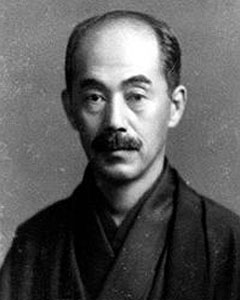 Photo provided by the Fukusaki
Photo provided by the FukusakiTown Board of Education
Kunio Yanagita(1875-1962)
Born in 1875, Kunio Yanagita worked as a bureaucrat in the Ministry of Agriculture and Commerce, Chief Secretary of the House of Peers, and as a privy councilor. Yanagita was also an active folklorist. Called the father of Japanese native folkloristics, Yanagita authored numerous books including “Tono Monogatari.” Yanagita's family lived along Gin no Bashamichi (somewhere around the Tsujikawa River area of Fukusaki today), and this birthplace is said to have fostered a healthy curiosity in the various information that travelled along the popular horse-drawn carriageway. Described as the birthplace of native folkloristics in Japan, his parents’ home has been relocated and preserved to the west of the Fukusaki Municipal Kunio Yanagita and Matsuoka Family Memorial Hall. Yanagita received the Order of Culture and became the first Honorary Citizen in his final years. He posthumously received the Senior Third Rank, First Order of Merit, and the Grand Cordon of the Order of the Rising Sun.
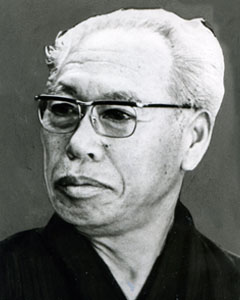
Courtesy of Ichikawa Town
Cultural Center
Takashi Shimura(1905-1982)
Takashi Shimura was born in 1905 in Ikuno Silver Mine company housing (employee residence Ko) in Kuchiganaya Valley, present day Ikunocho in Asago City. His father worked at the Ikuno Silver Mine as a metallurgical engineer at the Mitsubishi Ikuno mining station. Working his way from a stage actor to a film actor, Shimura played the old jujutsu teacher Hansuke Murai in Akira Kurosawa’s debut movie, “Sanshiro Sugata,” in 1943 and eventually took roles in 21 of the acclaimed director’s movies. Credited as “an indispensable actor in Akira Kurosawa’s works,” Shimura was acknowledged as the “best actor in the world” by the New York Times in 1952. A restored company house and mementos of Takashi Shimura are on display at the Takashi Shimura Memorial Hall, providing visitors a look into Shimura’s childhood and the times he grew up in.
 Satsuma Students
Satsuma Students
In 1865, amid Japan’s period of national seclusion, the Satsuma Domain saw the need to train capable human resources to meet growing interest in industry and advanced technologies arising in Europe and the United States. To fulfill this need, the Satsuma Domain dispatched 19 youths to study in the UK. The group, led by Tomoatsu Godai, included Moriaki Asakura, who would one day supervise the construction of Gin no Bashamichi. The students selected to study overseas learned a great deal in the UK, France, and other countries. Their experiences and knowledge gained provided a great leap forward in promoting the modernization of Japan. In honor of the accomplishments of the Satsuma Students, the Reimei Festival is held every year in the Hashima area of Ichikikushikino City in Kagoshima Prefecture. The festival includes elementary and junior high school students from throughout the Hashima area dressed as Satsuma Students in battle surcoats showing a magnificent performance reminiscent of those international students who defied the shogunate’s ban on travelling overseas with determination. The festival introduces each international student both in the Kagoshima dialect and in English. Carrying on the legacy of contributing to the modernization of Japan, the Satsuma Students Museum was opened in Ichikikushikino City in order to promote regional culture and tourism. The museum offers visitors the chance to learn about each student’s background as well as their time abroad and after they returned, from the conflicts that arose to the surprises, puzzlement, and the results of the experiences and training.
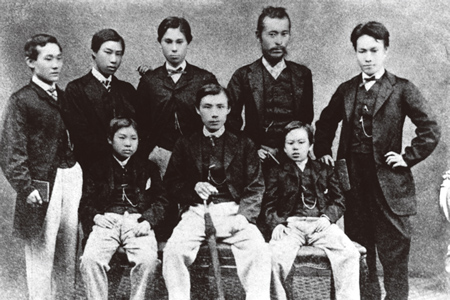 The Satsuma Students upon arrival in London
The Satsuma Students upon arrival in London(Moriaki Asakura is pictured in the back row on the left.)
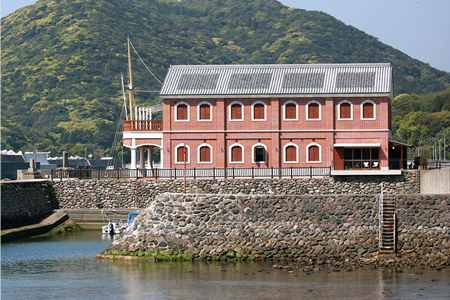 Satsuma Students Museum
Satsuma Students Museum
